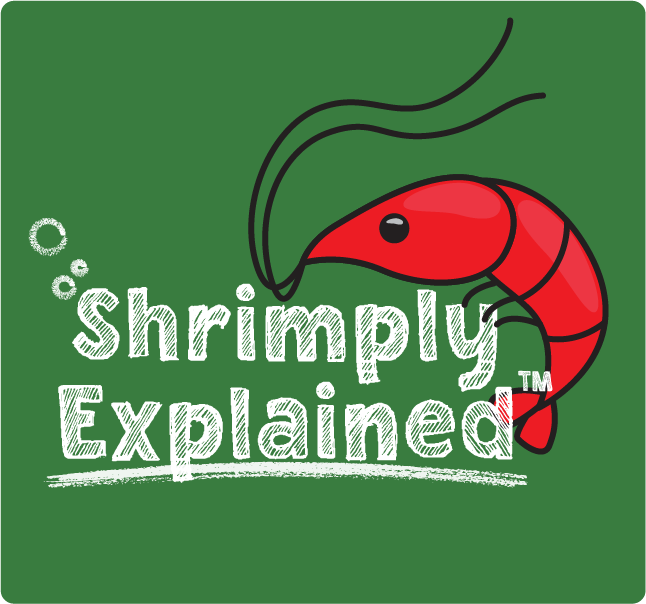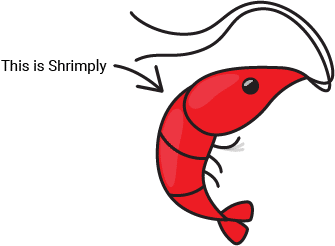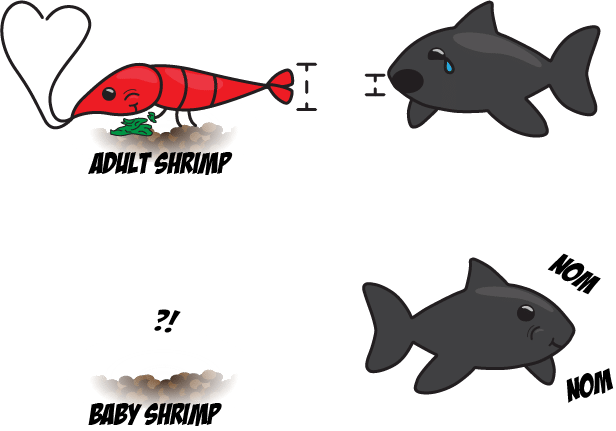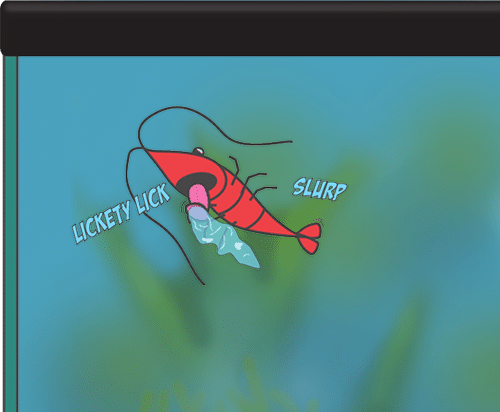


I’ll admit that I had trouble getting into shrimp at first. Partly because they're a little weird looking but mostly because it took a long time to sort through all the conflicting information online. Don’t get me wrong--there are some amazing resources from great shrimp keepers out there--but it’s hard to find everything you need in a single organized place.
The result? 60-80 hours spent researching my first shrimp tank and I still found extensive gaps in my knowledge that could have saved money and time. You shouldn't have to go through that, which is why Shrimply and I are here to help with Shrimply Explained. If you want to become a shrimp keeper quickly and have fun doing it, then just follow along with this course!
While larger shrimp species (amano, bamboo shrimp, etc.) are suitable for almost any community tank, smaller varieties like Neocaridina, ghost, and Caridina shrimp have limited options for tank mates. For example, many larger or more aggressive community fish--angel fish, loaches, barbs--will happily pop a cherry shrimp in their mouth, resulting in an enriched diet for your fish but a less rich You. This limits your selection of tank mates to fish that are peaceful and around 1.5 inches in length or less, because they physically cannot fit a shrimp in their mouth—Believe me, they would if they could.

While shrimp may be safe once reaching adulthood, babies easily fit in even a small fish’s mouth so you have to accept that some will be eaten. To be clear, I am not saying that fish cannot be kept with shrimp. They absolutely can coexist with only minor casualties if the shrimp are provided with lots of plants to hide in. In fact, this food web that develops is beneficial for your tank as the small number of shrimp that do get eaten provides a wider variety of protein for your fish, so your fish are healthier. In addition, fish can prevent overpopulation of shrimp, so less tank maintenance is required and you don’t need to worry about culling or selling any shrimp.
If, however, your goal IS to sell shrimp or at least breed enough to see an amazing feeding frenzy when you drop in food, then having any fish is a bad idea. For exceptions and recommendations for shrimp tank mates, please see the following article, which is written for Neocaridina shrimp but is also relevant to the smaller shrimp species mentioned previously.
It took me a while to get into shrimp. Initially, I watched a ton of videos online of colorful shrimp munching away on algae with relaxing music in the background and was excited to set up a tank for them. When the tank was finally ready and I went to the local fish store, looking at them in person was a very different experience. Seeing their numerous limbs flailing against the glass as they swam around gave me the impression of strange underwater spiders, so I didn’t buy any that day. Eventually, I went with cheaper Amano shrimp to test out the shrimp keeping hobby before committing to more expensive species like cherry or crystal red shrimp.
Keeping Amanos for a few weeks made me comfortable enough to buy cherry shrimp soon after, but some might feel the opposite and it’s best to learn this sooner rather than later. They are very unique animals and aren’t for everyone.

If you do find yourself on the fence about getting shrimp, then I would recommend following a similar path and starting with a few Amanos. They are hardy, great tank cleaners, and big enough to survive in community tanks with a wide variety of fish in case you decide more shrimp are not for you. Be sure to do your research on what Amanos look like, as many fish stores and hobbyists mix them up with other species.
Shrimp are more sensitive to changes in water parameters than fish, which means you must be diligent about water testing, water changes, and acclimation. For example, it is recommended to keep fish at 25ppm or less of nitrates, but they can survive with nitrate concentrations in the 40s. In contrast, shrimp tanks need to be kept below 20 ppm, as nitrate concentrations above that range for any period will likely result in the death of your shrimp. Considering the legal limit of nitrates in United States tap water is 40 ppm, you could easily add a dangerous amount to the tank if not careful. This is one reason many shrimp keepers use RO/DI water for water changes.
To add to the expenses, you need a way to test more water parameters (pH, GH, KH, ammonia, nitrites, and nitrates) when compared to fish keeping. Without testing, it is impossible to know when water changes are needed or what you are adding to your tank. There are reasonably-priced test strips available for most parameters, but the liquid test kits from API provide far better accuracy.
Lastly, water changes for shrimp tanks can be time consuming since you can’t just dump new water into your tank. Instead, you must either:
Both methods avoid rapid changes in water conditions so the shrimp do not get stressed. Drip acclimation kits can make this process much easier and are highly recommended, especially when introducing shrimp to a new tank.
Freshwater shrimp, especially the popular Neocaridina species, really put on a show in your aquarium as their colorful bodies glide gracefully through the water. Even the less colorful Amanos and ghost shrimp usually have at least a few attention-grabbing chromatic splashes on their shells. The eye-catching hues drag you in and then the fascinating variations in sizes, colors, and patterns can easily keep your attention for hours at a time (Okay, maybe not that long unless you’re really trying to procrastinate on something else, but my point is that shrimp are fun to watch. I don’t recommend keeping them in your office because it’s much harder to get work done.)
Did I mention that shrimp can also change color? This can happen due to diet, stress, molting, or their environment, and just makes it all the more fun to look in the tank since you never know what you’ll see.
These crustaceans are extremely alien, unlike any animal you encounter often. As such, observing shrimp for any amount of time always brings up interesting questions.
Why are all of them gathered around the filter? That’s where all the tasty dead stuff ends up.
How many appendages do they have? 28
Why the hell is that one swimming in circles? That’s just what Bob does.
For most questions you have, communities on Facebook, Reddit (r/shrimptank) or other social platforms are available to answer them, but you may find conflicting responses. This can be frustrating, but it can also lead to you doing your own research and learning something new. It’s all about learning a little bit more every day to keep your brain sharp. Keeping shrimp basically makes you smarter. These are just the facts.
Please note that Shrimply made me say that. As a disclaimer, shrimp are not actually proven to make you smarter and may result in long-term side effects such as: addiction, Multiple Tank Syndrome (MTS), or unprompted urges to discuss shrimp.
The beauty of the small size and fast reproduction rate of most shrimp species means that, if you can’t find the answer you want online, then you can test out different possibilities by setting up a bunch of smaller tanks (less than 1 gallon). This process can be similar to a school science class, except the information is actually relevant to you, which makes the experiment much more interesting. If you have kids, then these projects encourage an experimental mindset while also showing them how to care for and appreciate animals.
Another great aspect about shrimp is that some of the most popular varieties (Neocaridina and most ghost shrimp) reproduce rapidly. With just a stable tank and 5-10 individuals, you can have hundreds of individuals swarming around in a matter of months. In addition, genetic variation causes every shrimp to be slightly different, so you’ll always see new varieties.
Because they breed quickly, even small tanks can offer one the option to sell shrimp and make some money on the side. The price per individual is dependent on the grade of shrimp, but commonly-kept varieties can be sold for anywhere from $0.50-$6 USD per shrimp. If you manage to breed an extremely pure line or find a new stable color/pattern, then it’s possible to sell those shrimp for hundreds or even thousands of dollars to the right collector.
In addition to being a visually intriguing addition to your tank, shrimp act as a great clean-up crew to reduce maintenance on your tank. If left for a few days, uneaten food can start to rot and cause ammonia spikes in your tank, but shrimp are usually quick to gobble up anything edible. Their diligence to cleanliness also reduces the need for water changes or gravel vacuuming. The only time this doesn’t happen is if you overfeed your shrimp.
Another benefit you may know of is that shrimp eat excess algae growth in a tank, which is… somewhat true. Shrimp are detritivores, meaning they only eat dead or dying things. Therefore, if you have already started reducing light or nutrients to kill off/reduce algae, then shrimp quickly clean up the dying plant matter. Otherwise, you’ll see shrimp picking at healthy algae but they are actually pulling off biofilm from its surface instead, leaving the algae intact. The only exception to this rule is Amano shrimp, which do seem to have an impact on algae but that may be because they are voracious and don't care if they tear off live algae while searching for biofilm.

The last great thing about keeping shrimp is that algae growth on the walls of a tank is extremely beneficial for them. This is because algae provides additional surface area for biofilm to grow on. As such, shrimp keepers often spend less time with algae scrapers in their hands than other fish keepers.
Knowing that, you now have a great excuse if you are behind on tank maintenance and visitors ask “Why is there so much algae covering everything?”
“Oh, it… it’s for the shrimp! Algae is a great food source for them.”
Later... “Hey, I actually invited you over for something… Are you willing to accept our lord and savior, Shrimply the Great, into your life?”
To summarize SB101, shrimp may not be for everyone because they have a limited number of tank mates, look similar to insects, and can be sensitive to sudden changes in their environment. On the plus side, they keep your tank clean, are relatively easy to breed, and are beautiful, fascinating creatures that are very rewarding to take care of.
What did I tell you? A totally unbiased account of shrimp keeping. Hold your applause (a-claws, GET IT?!), please.
The next lesson (SB102) provides an overview of different types of shrimp available along with care instructions to decide if they are right for you. The lesson after that gets into the real substance of The Shrimp School by covering important water parameters and how to control them.